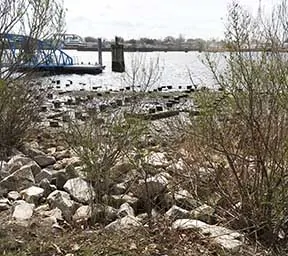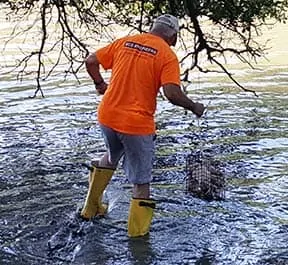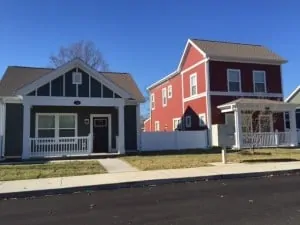

SCS Engineers periodically prepares Technical Bulletins to highlight items of interest to our clients and friends. Our most recent SCS Bulletin summarizes the Brownfields BUILD Act (Brownfields Utilization, Investment, and Local Development). The BUILD Act was signed into law in March 2018, amending the Brownfields provisions of the Comprehensive Environmental Response, Compensation, and Liability Act (CERCLA). Specific changes include increased eligibility for funding, additional liability protections, and changes to grant programs. The link above will take you directly to the summary.
SCS will continually update coverage of this Act on our website. I welcome you to use our staff resources for guidance or to answer questions.
On April 9, 2018, the U.S. Department of Treasury and the IRS approved Opportunity Zones for: American Samoa; Arizona; California; Colorado; Georgia; Idaho; Kentucky; Michigan; Mississippi; Nebraska; New Jersey; Oklahoma; Puerto Rico; South Carolina; South Dakota; Vermont; Virgin Islands; and Wisconsin. The Treasury Department has made the final designations of Opportunity Zones in more states during June 2018.
Use this interactive map to locate eligible zones in your state.
Opportunity Zones are communities where new investments may be eligible for significant tax incentives. The zones are based on Census Tracts that meet income criteria, and were created in the federal Tax Cuts and Jobs Act of 2017 as a means of helping economically depressed areas through tax incentives for new private investments.
Investors can defer tax on prior gains invested in a Qualified Opportunity Fund (a fund set up to make investments in Qualified Opportunity Zones). In addition, if investors hold the investment in the Opportunity Fund for at least five years they are eligible for capital gains tax reductions or exemptions. If they hold the investment in the Opportunity Fund for at least ten years, they are eligible for an increase in its basis equal to the fair market value of the investment on the date that it is sold.
Brownfields and Opportunity Zones
Many of the communities in the Opportunity Zones have properties impacted by environmental contamination. The Opportunity Zones program provides an economic tool to attract developers and financial backing to communities with brownfield redevelopment needs.
If you are interested in investing in a potential brownfield site, contact SCS Engineers to help you evaluate and manage environmental concerns associated with your site. Visit www.scsengineers.com to learn more.
Duluth, GA – SCS Engineers, a leader in environmental and solid waste engineering, recently relocated from Alpharetta to a larger, more strategically located office in Duluth, Georgia. The new office supports SCS’s continued development in the Southeast, our client success-driven growth, and accommodates our growing professional staff.
SCS is always on the lookout for talented senior level professionals in the environmental consulting community. The Atlanta Environmental Services (ES) group is seeking experienced, humble, hungry, and smart senior level consultants with client relationships and business development capabilities to join our team.
SCS Engineers – Atlanta
3175 Satellite Blvd
Building 600, Suite 100
Duluth, GA 30096
(678) 319-9849
If you are interested or know anybody who is interested, reach out to . You may also review our open positions on the SCS Careers Page.
Landfill Sites are Finding Second Lives as Real Estate Properties
Innovative projects have sprung up over the years that house retail, apartments, golf courses, conference centers and hotels. Engineers in the solid waste space are applying several structural design techniques that other industries have leveraged for years like building on piles, which has historically been done on marshlands and other unstable ground. They’re also designing floating foundations that allow for movement and making adjustments when differential settlements happen.
Over the years, SCS has designed landfill-related systems for dozens of projects, mainly apartments, business complexes, entertainment complexes, hotels, parks and golf courses. In the past three years,SCS has fielded calls from developers looking into options, resulting in projects moving into the development stages. From small to the largest landfill redevelopment project in the nation , this article gets you started and leads to more information.
by Ali Khatami, Ph.D., P.E., SCS Engineers
In south Florida, rising prices of vacant land and unavailability of large parcels of virgin land for development have forced land developers to look into developing old and newly filled lakes. The land price for these lakes is significantly lower than the virgin land and deals are arranged to incorporate the cost of improving the lakefill land into a developable land in the purchase price. Aside from environmental issues that are handled by environmental engineers in relation to obtaining development permits, the ground itself must be improved to sustain the stability needed to bear the proposed development load. Deep Dynamic Compaction (DDC) is proven to be the most economical option for low rise and lightweight developments, such as commercial or industrial warehouses.
The model developed for the Federal Highway Administration (FHWA) report entitled “Dynamic Compaction, Geotechnical Engineering Circular No. 1”, by Robert G. Lukas, dated March 1995, is the primary basis of most DDC programs. Experience of the engineer with the type of the material below the surface is important because the type of material plays an important role in selecting the DDC design parameters used in the model. The design methodology considers four categories of materials in pervious grained soil, semi-pervious soil, partially saturated impermeable deposits, and landfills. The fourth category, landfills, covers waste materials in old landfills but also the material used to fill lakes to create land for new development at a later date.
The material going into a lake may vary depending on the age of the fill placed in the lake. Older lakes filled with debris may include materials that today would never be allowed; while newer lakes are in accordance with state or local regulatory agency environmental permits, which follow a monitoring protocol during filling. The debris in newer lakes may consist of concrete debris, soils, tiles, and any other types of materials classified as clean debris in accordance with the material definitions in the rules.
There are three primary parties involved in this type of brownfields work including the developer, the banker, and the future buyer. Each party has a learning curve to understand and protect their interests.
Developers are cautious because they, very rightfully, have reservations regarding the effectiveness of DDC on the planned investment. Engineers will need several one-on-one and one-on-group teaching sessions with the developer’s primary engineer in charge of the project, and gradually meeting with the engineer’s boss, project director, and eventually the executives of the developing firm. Past successful experience with similar projects play a very important role in justifying the DDC methodology; engineers need to have accurate data and unit costs in tabulated form as part of their arsenal for convincing those in the learning curve.
The process becomes even more complicated when the engineer has designed the DDC program, prepared plans and specification for implementation of the program and the project goes to bid by DDC contractors. To win the work, it is typical for each DDC contractor in the bidding process to return to the client with their version of a DDC program and sometimes less expensive one to put themselves ahead of others. The alternative plans will propose using different equipment, usually the specific equipment that the bidding party already owns, or modeled under a different set of design parameters than the ones prepared by the engineer. Expect communications to become intense, and even with a now more educated developer, they will question every detail of the original planned design. It can be a frustrating and confusing period for all parties.
The engineer must plan to routinely justify his/her design based on design methodologies in literature, justify the design parameters used in the development of the DDC program, and rely heavily on the past performed projects going back a couple of decades. The engineer should even be prepared to obtain permission from past project owners to show the integrity of the building slabs after being in service for many years.
The DDC designer may also need to obtain design parameters from the DDC contractor who has come up with an alternative design to analyze their design and determine any shortcomings in it. If found, further discussions ensue to reexamine the design at hand as the most reliable and the most effective for the developer. Innovation is wonderful, but an expert engineer will not risk the developer’s investment and reputation using unproven technologies; proven technologies are already part of a reputable engineer’s DDC design.
The best way for inexperienced developers to go through the design and implementation phases of such projects is to find an experienced firm with a significant number of similar projects in its experience and trust the outcome of the work by that design firm. Otherwise, the developer will have a very difficult time sorting out the complexities and questions that alternative designs bring forward. The claims of less expensive scenarios without long-term performance justification as to how the foundation will behave over the long term are too risky. The combination of dealing with a new concept for which the developer has no experience and justifying the financial aspects of a properly designed DDC program can make a project even more difficult for an inexperienced developer.
A developer’s project manager should plan to spend significant time with the DDC designer to become familiar with the DDC concept, construction nuances, and the financial aspects of the project. The project manager will need to visit past projects performed by the designer’s firm to confirm claims by the design engineer. Only at that point, the developer’s project manager should proceed with convincing his/her superiors of the validity of the DDC program while asking for assistance from the DDC designer.
Ali Khatami, Ph.D., P.E., is a Vice President with SCS Engineers. He may be reached at
Additional resources are available on these pages: Brownfields and Voluntary Remediation and Environmental Due Diligence and All Appropriate Inquiries.
It is challenging to restore properties with a past, but you can do it on time and on budget if you plan ahead to address contaminated historic fill. Follow these tips and use the brownfield redevelopment checklist to keep your next redevelopment on track.
Design Phase
Consider how contaminated historic fill impacts the following:
Site feature locations – You can reduce or even eliminate landfill disposal costs by carefully selecting locations for your building, underground parking, parking lot, utility, and green space.
Storm water infiltration – Do you know that storm water infiltration devices must be located in areas free of contaminated historic fill? Infiltration devices cannot be located where contaminants of concern (as defined in s. NR 720.03(2)) are present in the soil through which the infiltration will occur.
Subslab vapor mitigation system – Already know you have contaminated historic fill on site? Consider adding a subslab vapor mitigation system to the design of your new building. It is usually much cheaper to install this system in a new building than to retrofit one into an existing building. It can also mitigate radon gas.
Planning & Design
Determine if contamination requires the following plans to manage the construction phase:
Material management plan – It establishes how you will separate excavated contaminated material from material that is not contaminated. It also outlines how you will handle contaminated material, either by disposing of it off site in a landfill or reusing it on site in an approved area such as a paved parking lot. This plan also covers screening, sampling, and testing contaminated materials, if required.
Dewatering plan – If the development requires excavation through contaminated historic fill to depths below groundwater, you will need a dewatering plan to properly manage discharge of the water. You may be able to discharge the water to the storm sewer or the sanitary sewer depending on the type and concentration of contaminants. You must determine local and state permit requirements before implementing your dewatering plan.
Demolition plan – The demolition plan for removing existing structures during redevelopment should include handling, removal, and disposal of potential contaminants such as lead and asbestos. The demolition plan should also address recycling and reuse of existing on site materials like concrete. You may be able to save money by crushing and reusing concrete on site as fill material, or by hauling and crushing it off site to reuse it as fill at another property. This approach can save you considerable money compared to landfill disposal.
Ready to start saving time and money addressing contaminated historic fill at your next redevelopment? Contact Ray Tierney for help evaluating your options in the Upper Midwest, or using the SCS Brownfield Redevelopment Checklist .
Live in another part of the country? SCS Engineers offers brownfields, remediation, due diligence, and all appropriate inquires services nationwide. Contact us today at .
Learn more about these services at SCS Engineers; read our case studies and articles:
Brownfields and Remediation
Due Diligence and All Appropriate Inquiries
Creosote is a toxic chemical that has been commonly used as a wood preservative for over 50 years. It acts as a pesticide, herbicide, and fungicide and has been used widely in both land and marine applications.

Studies have indicated that pilings and other artificial structures provide possible environmental benefits, such as habitat for invertebrates, roosts for birds, and a spawning location for certain fish species (e.g., herring). However, far more studies have indicated potential harm from treated structures. It is documented that pilings will leach the most during the first two years after installation after which leaching declines significantly.
The Norfolk Riverfront area has been developed since at least 1887, and the use of treated pilings can be presumed. The majorities of the pilings are presumed to
have been installed over two years ago and are therefore beyond the 2-year timeframe for significant leaching. Pilings that are shown to be in good condition and with a viable use as part of the development effort can remain in place with little effect on the surrounding environment.
This paper discusses the City of Norfolk’s waterfront brownfield redevelopment and the importance of understanding and developing an approach for the managed disposal of creosote pilings. The guidance is based on strategies approved by the U.S. Environmental Protection Agency and other noted expert sources such as waterfront municipalities, published white papers, and peer-reviewed publications.
Take me to the paper and information about the authors.

Other environmental groups are hard at work in the region. Lynnhaven River NOW, is one organization working with residents, businesses, and community leaders who are restoring and protecting Virginia Beach waterways.
Learn more here: http://www.lynnhavenrivernow.org/
San Diego County is in the midst of an affordable housing shortage — and more units could be lost as government-aided housing agreements expire over time. And the state of California isn’t fairing much better based on a report released by the California Housing Partnership Corporation. BRIDGE Housing, a firm formed in 1983 to address the affordable housing shortage, is doing their part to fill the gap.
One of their recent developments, COMM22, is a mixed-use, mixed income, transit-oriented development located at Commercial and 22nd streets. The development combines much-needed affordable family and senior rental housing with day care facilities, commercial and retail space, affordable townhomes that are currently under development, and future market-rate flats.
Join an esteemed panel of redevelopment and land reuse experts for a practical and interactive workshop that will provide project managers, real-estate developers and investors, the public sector, and allied professionals with the tools, techniques, and funding resources required to bring projects in on time and on-budget.
The Center for Creative Land Recycling is offering a free half-day workshop and walking tour in Vista, CA focused on fostering economic development and creating vibrant communities through land reuse. The workshop focuses on economic development through infill and reuse of underutilized and potentially environmentally challenged properties, such as brownfields, to create stronger economies. Come and learn how to jump-start your community’s redevelopment programs.
Then, end your day with an urban brew-newal tour of brownfields that were redeveloped as affordable housing and breweries.
May 23, 2017, 1:00 pm – 4:00 pm
Vista Public Library
700 Eucalyptus Ave.
Vista, CA 92084
To register: Click Here

Historic fill is common on properties that were once rural and have become prime redevelopment sites as communities expanded. The fill may include contaminated materials like foundry sand, ash, demo and construction debris, and even municipal waste. In the past, these materials were used to fill wetlands or change the grade of the property before initial development. Today regulations have evolved, and state agencies require property owners to manage these materials appropriately during redevelopment. Also, particular types of historic fill are often not robust enough to structurally support your new building.

There are many different kinds of fill materials – each with different physical properties and different potential contaminants. Knowing what is on your property before you start designing the site layout, and certainly, before you start digging, will help you plan your project to save time and money, and to receive state agency approval.
Before You Buy
The more you know about the property and the earlier you know it, the better prepared you will be to make decisions about how best to protect yourself from potential environmental liabilities and prepare for the environmental and geotechnical issues that historic fill can cause. Since every property is unique, the first thing you need to do is gain a thorough understanding of the property’s history and past use. Invest in a comprehensive Phase 1 Environmental Site Assessment (ESA). Consider it a starting point for clues about the possible types and amounts of historic fill which may be present on the property.
If the results of the Phase 1 ESA warrant it, conduct a Phase 2 ESA and geotechnical study to collect soil, fill, groundwater, and soil vapor samples. The Phase 2 ESA and geotechnical studies will help you understand if fill and contaminants are present and the best options for addressing them during the development planning stage.
Historic fill on a property is no longer the impediment to development that it once was. Take these steps to get ahead of potentially contaminated historic fill, and keep your project on time and budget.
By testing early, performing a proper geotechnical evaluation, and incorporating design adaptations where needed, you can successfully develop projects with historic fill within your schedule and without breaking your budget.
SCS professionals are available to answer questions or concerns you may have pertaining to commercial, residential, or private development on brownfields – we provide remediation, brownfields, and Environmental Due Diligence services nationwide. Contact or one of our experts.

Ray Tierney, PG, is a Vice President of SCS Engineers and one of our National Experts on Sustainability. He has 30 years of experience in environmental and sustainability engineering and has helped a wide range of organizations control and reduce their legacy environmental impacts and liabilities, lower their costs, obtain grants and permits to expand, and implement cost-saving practices. Ray serves the Midwest region and projects throughout the U.S.
JohnTabella, PG, LEED AP®, is SCS Engineers National Expert for Environmental Due Diligence and for Federal Services. In this capacity, he oversees all aspects of environmental services opportunities and projects primarily throughout the eastern seaboard and supports on opportunities and projects throughout the U.S.
Floyd Cotter specializes in solid waste management projects. His project work involves all areas of solid waste management including planning, permitting, transportation, landfill design, construction, and monitoring. Floyd is also experienced in general civil engineering, construction oversight, environmental site assessments, closure and post-closure plans, and permit and contract document preparation. Floyd is located in the Central region.
Randy Bauer has nearly 3 decades of experience conducting environmental site assessments, subsurface investigations, groundwater monitoring programs, soil and groundwater remediation, and geotechnical investigations at industrial hazardous waste and solid waste facilities. Randy is available to answer questions on the western seaboard.